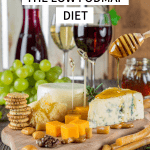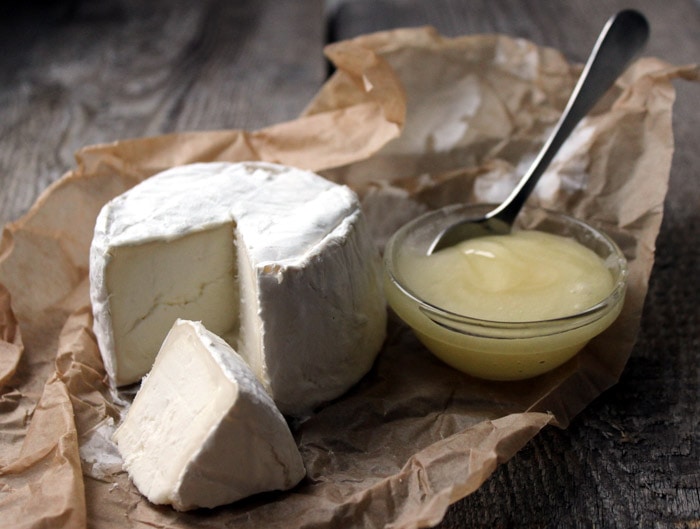
What cheeses are low FODMAP?
The FODMAP diet can be quite difficult and confusing. I regularly get reactions under recipes in which I use cheese that say “Why are you using cheese, that isn’t low FODMAP”.
In this blog, I am going to explain to you what the deal is with cheese on the low FODMAP diet and why we can eat quite a lot of different cheeses.
The low FODMAP diet is not a lactose-free diet
In the blog that I shared a while ago about lactose, I told you that the low FODMAP diet is not a lactose-free diet, but a low-lactose diet.
If you want to know more about this, you can best read my blog about lactose and the low FODMAP diet first. Monash University sticks to a limit of 1 gram of lactose for products that contain lactose.
When a serving of a dairy product contains less than 1 gram of lactose or less, it is considered low FODMAP.
Monash University says in the app that these serving sizes will be safe to eat for most people with IBS.
Important: we are speaking about “most people” here. This means that it is possible that you are more sensitive to lactose and might already get symptoms when a product contains a little lactose or only traces of lactose.
Or that you are less sensitive and can tolerate more lactose. In the reintroduction phase, you test how much lactose you can tolerate and later you can also test different dairy products to find out what your tolerance level for different products is.
During the elimination phase, you can stick to the serving sizes in the Monash app. If you find out during the first weeks that you react to low FODMAP servings of lactose, you can always choose to eat entirely lactose-free or even milk-free during the elimination phase.
You can best consult your dietician to make this decision together. In most cases, eliminating lactose is not necessary, and sticking to the low FODMAP serving sizes will work out fine.

Which cheeses are low FODMAP?
Ok, but what are the low FODMAP serving sizes for different kinds of cheese? I have listed this for you below. For each kind of cheese, I also mention the amount of lactose per 100 grams.
Note that this amount can differ per brand and kind of product, so it is always good to check the ingredient lists yourself.
How can you check if a cheese contains less than 1 gram of lactose?
You can do this by checking the nutrition label of the cheese and looking at carbohydrates / sugars on the label.
Lactose is a sugar. Because most cheeses don’t contain any added sugars or other sugars in general, next to lactose, you can trust that the amount of carbohydrates / sugars on the label is the amount of lactose that the cheese contains.
Low FODMAP cheeses that contain only traces of lactose
- Dutch yellow cheeses – For most Dutch yellow cheeses, such as Gouda cheese, the production process has removed the lactose almost completely from the cheese.
The more aged the cheese is, the lower the amount of lactose in it. Aged Dutch cheeses are usually completely lactose-free.
The younger variants of the cheeses can still contain traces of lactose and this can cause symptoms if you are very sensitive to lactose.
But for most people, traces will be fine. Dutch cheeses have not been tested, but the recommended serving size (looking at other hard cheeses) is expected to be 40 grams per serving.
The Dutch cheeses that I checked all contained 0 grams of lactose per 100 grams. - Swiss cheese – Swiss cheese only contains traces of lactose and is therefore low FODMAP. The recommended serving size is 40 grams.
- Cheddar – Cheddar is also a hard cheese and contains only traces of lactose (o.1 gram per 100 gram).
Make sure to pick a piece of hard cheddar or a grated version of that and check the package for the amount of carbohydrates it contains.
The slices of cheddar cheese, that are often used to put on hamburgers, often contain only a very small amount of cheddar and contain quite some milk. They are therefore high in lactose.
One package of cheddar slices that I found in a Dutch supermarket contained 6 grams of carbs. The recommended serving size for cheddar cheese (not the slices) is 40 grams. - Parmesan cheese – Parmesan cheese contains 0 grams of lactose per 100 grams and therefore is low FODMAP.
The recommended serving size is 40 grams. - Pecorino cheese – Pecorino cheese contains 0 grams of lactose per 100 grams and is low FODMAP. The recommended serving size is 40 grams.
Monash also states that pecorino contains a high amount of lactose in servings of 500 grams or more. - Brie – Brie contains 0 grams of lactose per 100 grams and is low FODMAP. The recommended serving size is 40 grams.
- Camembert – Camembert only contains traces of lactose and is therefore low FODMAP. The camembert that I found in a Dutch supermarket contained 0,1 grams of lactose per 100 grams.
The recommended serving size is 40 grams. - Feta – Feta contains only traces of lactose and therefore is low FODMAP. The feta that I found had 0 grams of lactose per 100 grams.
Make sure to check which feta you buy, the cheaper versions of feta (that are usually not allowed to be called feta) often contain a higher amount of lactose.
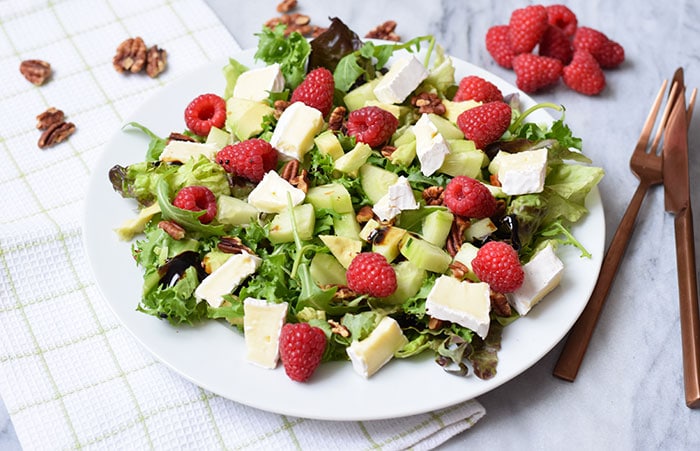
Cheeses with a low amount of lactose per 100 gram
- Ricotta – I was quite surprised about ricotta because I always thought it was high in lactose. The ricotta that I found contained 3 grams of lactose per 100 grams (this can differ per brand).
The recommended serving size is 40 grams. At 120 grams ricotta contains a moderate amount of lactose and at 200 grams it is high in lactose. - Halloumi – Halloumi contains a low amount of lactose. The halloumi that I found contains 2 grams of lactose per 100 grams.
A low FODMAP serving is 40 grams. At 60 grams halloumi contains a moderate amount of lactose and at 220 grams it is high in lactose. - Mozzarella – Mozzarella is low in lactose. The amount of lactose can differ per brand, so it is good to check the ingredients list.
I found that buffalo mozzarella contains less lactose than normal mozzarella. The recommended serving size is 40 grams. At 630 grams or more, mozzarella contains moderate amounts of lactose.
- Goat cheese – Goat cheese is low in lactose. The amount of lactose can differ per kind and brand. I found that soft goat cheese contained 2 grams of lactose per 100 grams.
In the Netherlands, you can also buy aged slices of goat cheese. The ones I found had 0 grams of lactose per 100 grams. The recommended serving size (for soft goat cheese) is 40 grams.
At 250 grams it contains a moderate amount of lactose. Aged goat cheese has not been tested, but because it contains less lactose, you can probably eat a bit more of it. - Blue cheese – Blue cheese has not been tested, but because it contains little lactose, it is probably low FODMAP.
The gorgonzola that I found contained 0,5 grams of lactose per 100 grams. The recommended serving size is probably also 40 grams. - Cottage cheese – Cottage cheese contains a low amount of lactose and therefore has a low FODMAP serving size. The amount of lactose can differ per brand.
I found brands that contained 1,6 grams of lactose per 100 grams up to 3 grams per 100 grams. The recommended serving size is 40 grams.
At 60 grams cottage cheese contains an average amount of lactose and at 210 grams it is high in lactose. - Cream cheese – For cream cheese, I found different amounts of lactose per 100 grams. From 2,4 grams up to 4 grams.
Monash gives a low FODMAP serving size of 40 grams and says that cream cheese contains a moderate amount of lactose from 80 grams.
If you want to eat cream cheese, I would advise picking one with as low an amount of lactose as possible. If you want to eat a larger serving, you can also choose lactose-free cream cheese. - Quark – Quark usually contains around 3-4 grams of lactose per 100 grams, depending on which brand you choose. A low FODMAP serving is 40 grams (2 tbsp) and at 60 grams (3 tbsp) quark contains an average amount of FODMAPs.
As this is not a lot, you can better choose a lactose-free quark if you want to eat a normal serving size of quark.
Note: cheese is relatively high in fat. Monash University advises to not eat cheese in large servings because fat can also be an IBS trigger.
That is probably one of the reasons why most serving sizes aren’t bigger than 40 grams. You can always test for yourself if you tolerate a little more or not.
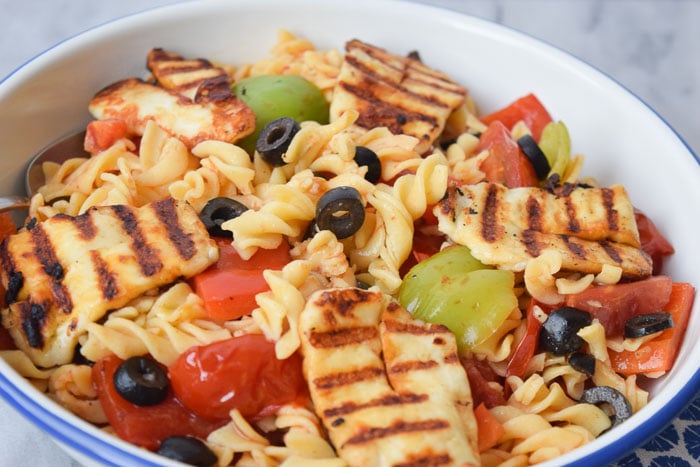
Cheeses that haven’t been tested
The cheeses that I have listed above have been tested (unless I said otherwise) and are in the Monash app.
For cheeses that have not been tested, you can look at the number of carbohydrates (sugars) per 100 grams.
The fewer carbohydrates/sugar a cheese contains per 100 grams, the less lactose is in it and the larger the chance is that it is low FODMAP.
As I have said before, your tolerance level for lactose is very personal and therefore it is important that you test for yourself how much lactose you tolerate. I hope that I have been able to help you with this blog! If you have any questions about cheese and the low FODMAP diet, feel free to ask them below.
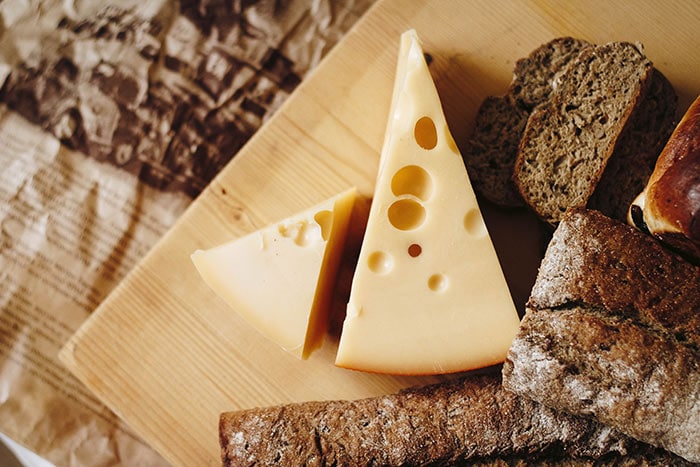
Do you find these kind of blogs interesting and helpful? Then check out my other blogs in this series in the FODMAP info category:
- Lactose and the low FODMAP diet
- Is spelt low FODMAP?
- Why gluten-free isn’t always low FODMAP
- Is butter low FODMAP?
Sources used for this article:
- Lactose and dairy products on the low FODMAP diet – Monash University
- Low FODMAP diet app – Monash University
Other blogs about the FODMAPs in foods
Would you like to read more about whether certain foods are low FODMAP and in what quantities? Check out the articles below:
Fruits and vegetables
- Are tomatoes low FODMAP?
- Is coconut low FODMAP?
- Are bananas low FODMAP?
- Are mushrooms low FODMAP?
- Is broccoli low FODMAP?
- Is kale low FODMAP?
- Is spinach low FODMAP?
- Is corn low FODMAP?
- Is avocado low FODMAP?
- Is sweet potato low FODMAP?
Dairy and grains
- Is rice low FODMAP?
- Is quinoa low FODMAP?
- Are oats low FODMAP?
- Which milk is low FODMAP?
- Is butter low FODMAP?

